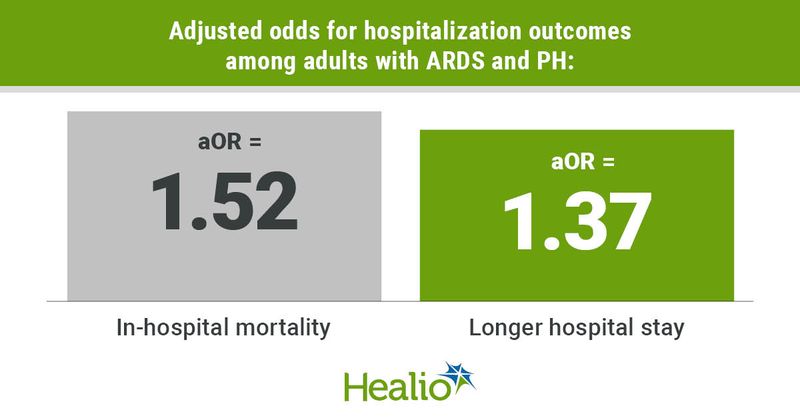ARDS plus pulmonary hypertension raises odds for mortality, longer hospital stay
Key takeaways:
- Pulmonary hypertension plus acute respiratory distress syndrome resulted in poor hospital outcomes.
- Odds for in-hospital mortality, extended stays and higher total cost went up with pulmonary hypertension.
HONOLULU — Patients with pulmonary hypertension hospitalized with acute respiratory distress syndrome had increased odds for mortality, extended stays and higher costs, according to research presented at the CHEST Annual Meeting.

“For the everyday clinician, our findings emphasize the importance of being vigilant about the potential presence of pulmonary hypertension (PH) in patients with ARDS,” Kaushik Kumar, MBBS, resident physician at MedStar Health Internal Medicine and postdoctoral researcher at Johns Hopkins Medicine, told Healio. “Recognizing and diagnosing PH early in ARDS patients can be crucial given its association with worse outcomes, including higher mortality rates and longer hospital stays.

“In practical terms, clinicians should consider monitoring and managing PH as an integral part of ARDS patient care,” Kumar added. “This approach can lead to better patient outcomes and more efficient health care resource utilization.”
In a retrospective analysis, Kumar and colleagues assessed 156,687 adults hospitalized with ARDS from the National Inpatient Sample database between 2016 and 2018 to determine whether PH, “a recognized consequence” of this disease, leads to poorer outcomes in terms of in-hospital mortality, length of stay and hospitalization costs.
There were 16.8% of patients (n = 26,324) with PH, and these patients tended to be older, women and have more comorbidities than hospitalized patients without PH, according to researchers.
Outcomes
Among those with both ARDS and PH, 36.8% died in the hospital, which was higher than the in-hospital mortality rate of 24.6% observed among those with ARDS and without PH. Between the two sets of patients, those with PH also spent more time in the hospital (12 days vs. 10 days) and had higher costs ($210,165 vs. $160,683).
“The significant differences in in-hospital mortality rates, length of stay and total hospital charges between ARDS patients with and without PH were more pronounced than initially hypothesized,” Kumar told Healio.
During multivariate logistic and linear regression analyses that accounted for age, gender, comorbidities and hospital characteristics, researchers found heightened odds among adults with PH for both in-hospital mortality (adjusted OR = 1.52; 95% CI, 1.46-1.58) and an extended hospital stay (aOR = 1.37; 95% CI, 1.35-1.38).
These adjusted analyses also revealed a mean difference of $19,406 (95% CI, $18,482-$20,329) in total hospital expenditures between patients with vs. without PH.
“The odds ratio of in-hospital mortality and the substantial difference in total hospital expenditures highlight the severity and financial implications associated with coexisting PH in ARDS patients,” Kumar told Healio. “It underscores the importance of recognizing and managing PH in these patients to potentially improve outcomes and reduce health care costs.
“Our study underscores the importance of a tailored approach in managing ARDS, especially in the presence of PH,” Kumar added. “Clinicians should be equipped with the knowledge and tools to identify and address PH early on, potentially altering the course of the disease and improving patient outcomes.”
Future research
When considering future studies, Kumar highlighted five areas that should be different or newly evaluated when conducting further research on this topic, with the first one being mechanistic exploration.
“Our study highlights the association between PH and worse outcomes in ARDS patients, [and] future research could delve deeper into the mechanisms underlying this association,” Kumar told Healio. “Understanding the pathophysiological relationship can pave the way for targeted therapeutic interventions. While vessel obliteration, microthrombosis and pulmonary vasoconstriction due to factors such as hypoxia and hypercapnia are known contributors, research can focus on the nuanced roles these play at different disease stages. For instance, the subsequent pulmonary vascular remodeling that occurs later in the disease process can be a focal point of future studies.”
Future studies could also adopt a prospective design, Kumar said.
“This would allow for real-time monitoring and intervention and could potentially provide a clearer causative relationship between ARDS, PH and associated outcomes,” he said. “Trials involving pulmonary vasodilators had mixed results, likely due to the heterogeneity of populations and their primary focus on oxygenation. Future trials might target not just oxygenation but also pulmonary hemodynamics, aiming to see if improved right ventricular (RV) function indeed translates to better patient outcomes.”
Analyzing the role of sepsis and mechanical ventilation effects could also provide more insight on the topic, according to Kumar.
“With RV dysfunction seeming to be associated with sepsis, a deep dive into understanding the unique contribution of sepsis- and nonsepsis-related inflammation to the pathogenesis of PH and RV dysfunction within the ARDS framework can be pivotal,” Kumar told Healio. “[Additionally,] the inherent relationship between mechanical ventilation, ventilator-induced lung injury, and increased inflammation suggests that future studies might look into optimizing ventilation strategies to reduce pulmonary vascular injury.”
Lastly, Kumar said that future studies could assess the long-term outcomes of PH in ARDS survivors. These include lung function, quality of life and long-term morbidity.
“Interdisciplinary collaboration between pulmonologists, cardiologists and critical care specialists can be pivotal in ensuring comprehensive care for these patients,” Kumar told Healio. “As the field progresses, I hope our study acts as a catalyst for further research, fostering a deeper understanding and ultimately better care strategies for those afflicted with ARDS and PH.”
Reference:
- Outcomes in patients hospitalized with ARDS with and without pulmonary hypertension. Published Oct. 2, 2023. Accessed Oct. 2, 2023.

